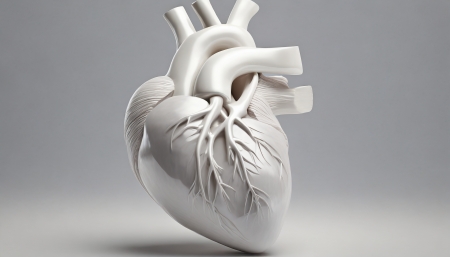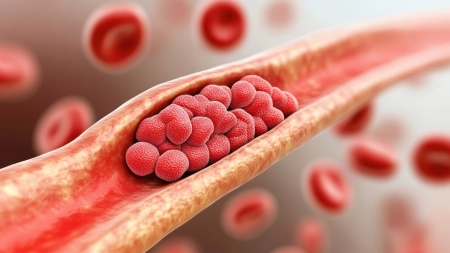Heart attacks: what are the signs and causes?
A heart attack is very rarely an inevitable fate. What are the signs of a heart attack and how is it treated?

Symptoms of a heart attack
The most common symptoms of a heart attack are the sudden onset of severe pain in the chest, which can radiate into the left arm and/or the jaw. Sweating, nausea, vomiting and sometimes breathlessness are common accompanying symptoms.
Women or diabetics in particular may experience different symptoms, such as pain in the abdomen or back or they may feel pressure in the chest. Any pain in the chest or upper abdomen that lasts longer than 15 minutes may indicate a heart attack.
If you are in any doubt as to whether or not you are having a heart attack, it is better to call the ambulance once too often than once too little – even if it is three o'clock in the morning. This is because the potential damage to your heart may only get worse the longer you wait.
Causes of a heart attack
The heart muscle beats around 100,000 times a day, which is a tremendous feat. With each beat, the heart pumps blood to all parts of the body. To ensure that it is “firing on all cylinders”, the heart muscle needs a sufficient supply of oxygen and nutrients, both of which are supplied by oxygen-rich blood. Blood is transported to the heart muscle via three arteries, known as the coronary arteries.
Inflammation may build up in the coronary arteries over time, which damages the innermost layer of the arteries. The consequences: deposits can form in the damaged areas causing the artery walls to thicken and become stiff. Cholesterol is one of these deposits is and it can become calcified. Colloquially, this process is called “hardening of the arteries” but doctors refer to it as atherosclerosis. Atherosclerosis is a disease that can affect the arteries anywhere in the body. It can become noticeable in the coronary arteries in the form of chest pain during physical activity, which disappears again in a matter of minutes after a short rest.
This is because the deposits cause the narrowing of the arteries which then obstructs the flow of blood to the heart. This can result in circulation problems. The heart muscle is no longer supplied with enough oxygen and nutrients. If an arterial deposit breaks off, blood clots can form at the site, which can lead to a complete and sudden blockage of the affected artery. This means that part of the heart muscle is starved of oxygen and nutrients, resulting to irreversible tissue damage. This is what causes a heart attack.
Treating a heart attack
In the case of a recent heart attack, treatment is geared towards minimising the amount of tissue death. The most important step is to restore blood circulation quickly. Nowadays, this is usually done via a coronary intervention (coronary angioplasty), less frequently also via bypass surgery.
A coronary angioplasty involves the heart specialist (cardiologist) inserting a thin catheter via a blood vessel in the arm or leg and threading it into the heart where the artery is narrowed. A small balloon is then inflated in order to expand the narrowed area. A tiny mesh tube called a stent located at the tip of the catheter ensures that the narrowing cannot close again.
If more than one blood vessels is narrowed, a bypass procedure may be required. This involves grafting an artery or vein from the leg, arm or inner chest wall to the heart in an operation that takes several hours to complete. The blood vessel then assumes the role of the coronary heart artery that has narrowed.
Strong painkillers such as morphine help to reduce stress and anxiety. Beta blockers lower the patient’s heart rate so that the cardiac muscle has less to do. Blood thinners are needed to prevent blood clots. Also, medicines to lower cholesterol inhibit arterial inflammation and reduce the risk of further deposits building up in the arteries and therefore of another heart attack.
Consequences of a heart attack
At the site where the heart muscle has died, the elastic muscle tissue is replaced by scar tissue. This can reduce its previously powerful capacity for pumping blood. If the damaged area is extensive, heart failure will occur because the remaining heart muscle cannot compensate for what has been lost. The patient may also develop an irregular heart beat because the scar tissue can impair the heart’s rhythm. Sometimes patients need to be fitted with a defibrillator or pacemaker.
Once the acute phase is behind them, patients can gradually resume their former lives. Depending on the severity of the heart attack, patients may be able to return to work within a few days. Travelling, sexual intercourse and hobbies are also feasible after a short period. It is important that patients continue to take their prescribed medication regularly.
Cardiac rehabilitation
A heart attack is a life-changing event. Rehabilitation is highly recommended to enable patients to rebuild their confidence in their body and recover quickly. It is something that everyone who has suffered a heart attack should do. Cardiac rehabilitation includes a programme of physical exercise, counselling, psychological support and tips on how to manage stress. Rehabilitation can be provided on an outpatient basis close to home and in some cases at home, or in a specialised rehabilitation clinic. It runs for three to four weeks on an inpatient basis and up to twelve weeks on an outpatient basis (which can also be done on a part-time basis when the patient returns to work). Rehabilitation enhances the long-term success of the treatment. Use this opportunity – for the good of your heart!
Risk factors associated with a heart attack
A heart attack is very rarely an inevitable fate. In many cases it is caused by poor lifestyle choices. You can take steps to prevent things from getting that far: one of the most serious risk factors is smoking. It is the only risk factor that can be eliminated entirely. High blood pressure, diabetes, high cholesterol levels, being overweight, not getting enough exercise, unhealthy eating and stress also contribute to atherosclerosis.
Furthermore, the tendency to develop atherosclerosis is to some extent hereditary. If a close relative (parents, grandparents or siblings) suffers a heart attack or stroke before the age of 60, you should take heed and inform your doctor.
Preventing heart attacks
The damage done to arteries by a heart attack is irreversible. That is why prevention is so vital – even long before the symptoms of a heart attack manifest themselves.
The most important thing is to maintain a healthy lifestyle: refrain from not smoking, get plenty of exercise, maintain a healthy weight, follow a healthy diet and ensure you get adequate rest.
A Mediterranean-style diet that is rich in vegetables and low in animal fats is recommended and beneficial for heart health.
High blood pressure, diabetes and high cholesterol levels are all factors that can contribute to arterial plaque build-up. In this case, an individually tailored course of medication plays an important role in preventing heart disease. Together with your doctor, you may have to fine tune things a bit to determine which medication is best for you. But it is worth the effort.


